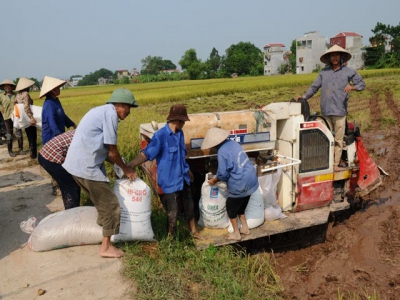Improved Vietnamese rice meets EU standards, says top official

The EU-Vietnam Free Trade Agreement (EVFTA) is creating conditions for Vietnamese enterprises to increase rice exports to the EU. Vietnam Economic News’ Phuong Lan spoke about this with Tran Quoc Toan, Deputy Director of the Ministry of Industry and Trade’s Agency of Foreign Trade.
What is your assessment of Vietnam’s rice exports in the first nine months of this year?
Since early this year, the Covid-19 pandemic and natural disasters have affected Vietnam’s economy in general and the country’s rice industry in particular. Specifically, the consumer psychology has been affected, while the fact that countries increased rice purchases and reserves increased demand. The Prime Minister, ministries and sectors have operated rice export activities on a flexible basis and in accordance with Government Decree 107/2018/ND-CP on rice export and the Law on Foreign Trade Management. This helped farmers sell their rice, ensure a sufficient supply for the domestic market, and maintain stable export prices.
According to the General Department of Vietnam Customs, in the first eight months of this year, Vietnam exported 4.61 million tonnes of rice to 150 countries and territories, up 0.6 percent in volume and 13 percent in value from the same period last year. Asia remained the biggest importer of Vietnamese rice, accounting for more than 60 percent of the country’s total rice export value, followed by Africa (19 percent), and Europe (two percent).
The rice export structure has gradually changed, with the proportion of low and middle-grade products decreasing and that of high-quality products increasing to meet foreign consumers’ needs and tastes.
Rice exports increased sharply in the first several months of this year. Do you attribute this to the falling supply of rice and/or the improved quality of Vietnamese rice?
Both. In the first several months of this year, the Covid-19 pandemic and natural disasters increased foreign countries’ demand for rice for both consumption and reserves. This helped Vietnam increase rice exports.
In addition, rice exports soared in terms of value due to Vietnam’s increase of high quality rice production and exports to such discerning markets as the EU, Japan, and the Republic of Korea (RoK).
The EU provides Vietnam with an annual quota of 80,000 tonnes of rice at zero-percent tax, which is expected to help the country further improve its rice quality. Do you think it will?
According to the General Department of Vietnam Customs, each year Vietnam exports about 100,000 tonnes of rice to the EU. Since the EVFTA took effect in early August, the EU applies strict quality standards, including food safety, traceability, and product labeling regulations to Vietnamese goods, including rice. According to Government Decree 103/2020/ND-CP on the certification of fragrant rice varieties exported to the EU, fragrant rice exporters to the EU must meet requirements related to sources of seeds, cultivated areas and production location. Fragrant rice must be produced from fragrant rice varieties with seed quality in accordance with National Technical Regulations, provide clear information on planting areas, and fragrant rice fields must be tested before harvesting and a written record of such a test must be made according to the provided form.
The reduction of tax rates also makes Vietnamese rice in the EU more competitive than products of the same kind from other countries. We hope that the quota will help increase Vietnam’s rice exports to the EU and encourage many domestic enterprises to export rice to this market. It is also expected to encourage businesses to invest, research and produce many other rice varieties for export to the EU, apart from the nine rice varieties that have been licensed to access this market.
Does Vietnamese rice meet EU standards?
According to Government Decree 107, rice traders must have professional storehouses for storing paddy and rice in conformity with national standards and technical regulations on rice depots, grinding facilities or rice processing facilities compatible with the national standards and technical regulations on warehouses, and rice grinding and processing facilities; invest in growing areas, work closely with farmers, and have strict farming processes to produce high quality products for export to discerning markets. I believe that Vietnamese businesses are able to satisfy the EU market’s requirements.
At the 2019 World’s Best Rice contest, Vietnamese premium fragrant rice ST25 was named the best rice variety in the world.
Ministries, sectors and localities have been assisting enterprises to develop the rice industry. The Ministry of Agriculture and Rural Development, for example, launched a Vietnamese rice branding project. Different localities have planned rice growing areas and refining centers, and created chains linking cooperatives, farmers with producers and exporters. Businesses are applying strict production processes to create high quality rice meeting the EU’s standards.
Có thể bạn quan tâm
 Public-private co-operation helps Mekong farmers overcome double challenge
Public-private co-operation helps Mekong farmers overcome double challenge Pham Thanh Tri, a farmer in Son Dong District in the Mekong Delta province of Ben Tre, is happy since he will be able to harvest around one tonne of pomelo
 Luc Ngan – the land of all year round fruits
Luc Ngan – the land of all year round fruits The key fruit producing area in the Northern areas with high quality fruits such as orange, pomelo, ongan, guava, jujube....which help bring high income
 Agriculture ministry working on project to develop agricultural processing
Agriculture ministry working on project to develop agricultural processing A programme to improve vegetable and fruit processing is set to be submitted to the Government for approval, focusing on both growing zones and processing